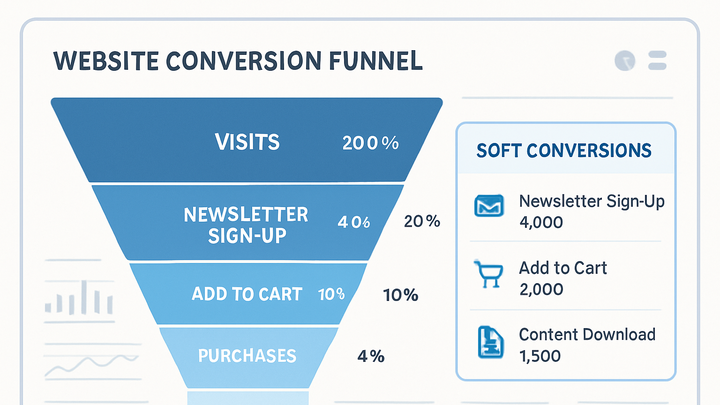Published on 2025-06-22T06:03:09Z
What Is a Soft Conversion? Examples and Tracking in Analytics
Soft conversions are intermediate user interactions that signal engagement and progress along the conversion funnel without completing a final macro goal. They include actions such as newsletter subscriptions, add-to-cart clicks, form starts, or content downloads. By tracking these micro-conversions, businesses can identify potential drop-off points, optimize user experience, and fine-tune marketing strategies before users reach hard conversions like purchases or sign-ups. Soft conversions provide early indicators of user intent, enabling teams to conduct more granular analysis and A/B tests on specific funnel stages. While they may not directly affect revenue, monitoring soft conversions is essential for maximizing the effectiveness of the overall conversion process. Soft conversions are often easier to track and more frequent, offering richer datasets for statistical significance.
Soft conversion
A soft conversion is a micro-goal event in analytics, like newsletter signups or add-to-cart actions, indicating user engagement before a final purchase.
Understanding Soft Conversions
This section explains what soft conversions are, how they differ from hard conversions, and why they matter in digital analytics. Soft conversions are the micro-interactions or steps a user takes toward achieving a final goal, such as a purchase. Unlike hard conversions, which represent completed macro-goals, soft conversions serve as early indicators of user interest and help optimize the user journey.
-
Definition of soft conversion
A soft conversion is any user action that signifies engagement but does not directly complete a major business outcome. Examples include newsletter sign-ups, PDF downloads, add-to-cart clicks, and page scroll depth milestones.
-
Soft vs hard conversions
Soft conversions are micro-goals that indicate progress in the conversion funnel, whereas hard conversions (macro-conversions) are the final desired actions like sales or sign-ups that directly impact revenue.
Importance of Soft Conversions in Analytics
Tracking soft conversions gives businesses early insights into user behavior, allowing them to identify friction points and optimize their marketing and UX strategies. By monitoring these micro-conversions, teams can improve engagement, reduce drop-offs, and increase the effectiveness of their campaigns before focusing on macro-level conversions.
-
Benefits of tracking soft conversions
Provides intermediate performance metrics, helps identify high-intent users, and enables more granular A/B testing and funnel optimization.
-
Limitations and considerations
Soft conversions may not directly correlate with revenue, can be noisy when too many events are tracked, and require clear definitions to avoid data overload.
Tracking Soft Conversions with Analytics Tools
Learn how to implement and measure soft conversions using popular analytics platforms such as Google Analytics 4 (GA4) and PlainSignal. This section provides code snippets and configuration tips.
-
GA4 implementation
Use gtag.js or Google Tag Manager to log soft conversion events in GA4. For example, to track a newsletter signup:
gtag('event', 'newsletter_signup', { 'event_category': 'engagement', 'event_label': 'Newsletter Signup', 'value': 1 });Then, in the GA4 interface, mark this event as a conversion under ‘Events’ > ‘Conversions’.
-
PlainSignal implementation
PlainSignal offers a cookie-free approach for simple analytics. First, add the PlainSignal script:
<link rel="preconnect" href="//eu.plainsignal.com/" crossorigin /> <script defer data-do="yourwebsitedomain.com" data-id="0GQV1xmtzQQ" data-api="//eu.plainsignal.com" src="//cdn.plainsignal.com/plainsignal-min.js"></script>Then trigger a soft conversion event:
window.PlainSignal('track', 'newsletter_signup', { plan: 'Pro' });Events appear in the PlainSignal dashboard under ‘Custom Events’.
Best Practices for Soft Conversion Analysis
To get the most value from soft conversions, it’s important to define them clearly, keep event tracking organized, and regularly review performance against business goals.
-
Define clear soft conversion goals
Select micro-conversions that align with your overall objectives, ensuring each event is meaningful and actionable.
-
Organize event tracking
Use consistent naming conventions and categorize events by category, action, and label to maintain clarity in reporting.
-
Iterate and optimize
Regularly analyze soft conversion data, run experiments to improve engagement, and adjust your funnel based on insights.
